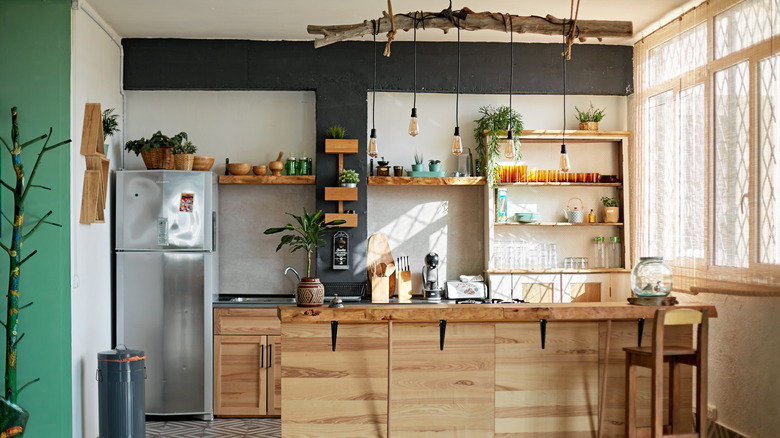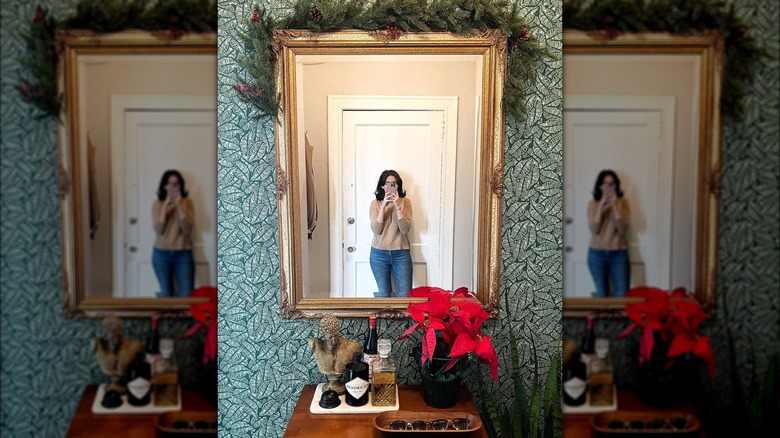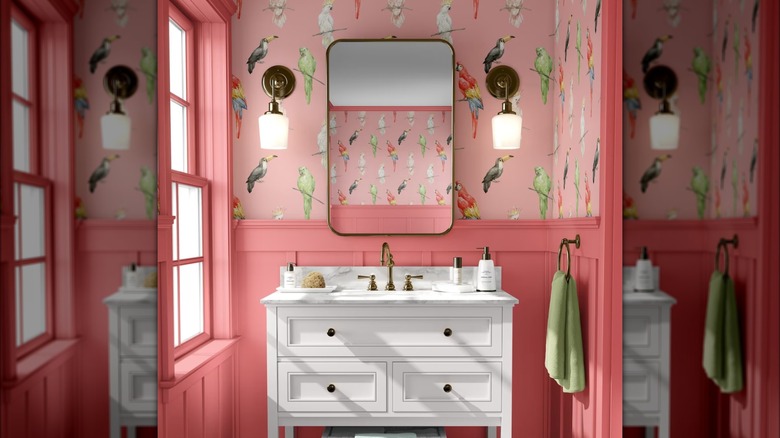The Simplest Way To Add Bold Color To Your Home When You're Not 100% Sure
Change is scary, especially when redecorating or renovating your home. Whether the carpet is being replaced, a backsplash is being added to a wall, or old furniture needs to be updated, choosing a design aesthetic can be overwhelming. And when renovating a home, the hardest thing to decide is choosing what statement color to add to each room. You can pick an interior style that helps narrow down a color palette, yet you're still left with a plethora of options. But don't fear: The best way to add bold color to your home when you're not 100% sure is by adding a strip of wallpaper to the space.
Instead of painting an entire wall a color you didn't love, a single strip of removable wallpaper will solve all your problems. Wallpaper is made in hundreds of colors, patterns, and styles that can easily be applied and removed when you're tired of it. Plus, wallpaper makes an excellent statement piece in any room. Perhaps the kitchen needs a pop of color, but tile backsplash is too much of a permanent job; apply removable wallpaper in a color or pattern you want to use but are unsure if it'll complement the interior. Once it's attached to the wall, feel it out for a few weeks, and if you hate it, remove it — but if you end up loving it, keep it.
Create an accent wall with wallpaper
Removable wallpaper is a godsend for those who don't have artistic skills. Some folks can get away with painting a gorgeous mural on a wall to make it stand out, but if you don't have the skills to paint on a blank wall free-handedly, then wallpaper will be your best friend. It's also more affordable than permanent, customizable wallpaper, especially if you're using a strip. You can spend $20 to $45 per roll of peel-and-stick wallpaper, whereas regular wallpaper would cost between $20 and $270 per roll. It will help elevate and break up a room and allow you to switch it out when you're ready for a new look.
For instance, if a massive wall in the living room is in an awkward place, dressing it up with an end table can help spruce it up and give it texture. However, a mundane paint color will make it look dreary; instead, add wallpaper to bring in some color. You don't have to cover the entire wall with wallpaper; instead, use a strip to cover the area behind the end table to draw focus.
On the other hand, neutral living room interiors benefit from colorful patterns and hues to add contrast and boldness. Suppose you have a gray living room interior. Adding a strip of removable yellow patterned wallpaper behind the furniture will help divide the ample space. Once you're ready for a change, swap the color for a sage green pattern.
Use wallpaper to highlight features in a room
Wallpaper adds personality to any room in the house. You can use it to highlight features in a room that you want guests to see when they first walk inside. For instance, if you decide to renovate your bathroom and want to add a bold tone, a strip of wallpaper can help you visualize what it would look like if it had a permanent color change. A nautical-theme bathroom can have blue-striped, boat, or anchor-patterned wallpaper behind the mirror or sink to make it stand out.
Installing removable wallpaper in the upper half is phenomenal as a statement piece for a bathroom, bedroom, or living room with layered trim. Further, spruce up the upper half with light fixtures or floating shelves in any room. Patterned wallpaper can sometimes make the space feel smaller if it covers an entire wall, so opt for a strip, but single-toned colors can make a small bathroom appear bigger.
If you don't have a specific area you want to highlight, wallpaper can be an excellent option to create a new reading nook. Lonely corners between a couple of windows are the perfect spot to add a strip of bold-colored wallpaper. Place a chair and a small side table in front to create a cozy corner. You can also highlight archways around the house with a strip of wallpaper surrounding the arch to give these architectural details even more character.


